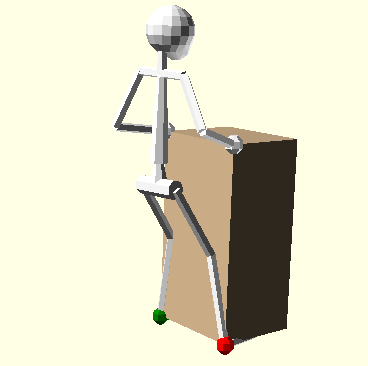
Animation 1: Hip and Shoulder Rotation Moves a Box
Want to enjoy the amazing experience of flying down a trail on a magic carpet? Riding a Trikke captures that wonder pretty closely from the undulations under the feet and hands to the mystery of just what makes it go. But how does one learn the gestalt of something so subtle and devorced from experience that it is challenging to give instructions, difficult to demonstrate live or to notice in a video? How does one figure out what the rider is actually doing? Changes are small, rapid and nearly simultaneous. Everything is in motion. In this visual approach, confusion due to the rotation and shifting of the vehicle's sidewinding path is illiminated. Animation allows unprecidented focus on the rider along with explanation and instruction. Hope to see you flying by on the trail; a master of the Trikke experience.
A Trikke moves because you transfer rotation from your body to the Trikke. Think corotation; one thing spinning around an axis causing another thing to rotate around another axis. Windup your body by spinning your hips and shoulders while turning the Trikke. That transfers half of your body rotation to the Trikke. When you stop spinning, the other half of your angular momentun transfers to the Trikke. Momentum transfers as you start to spin and as you stop spinning. It sounds easy, but it is why riding a Trikke is so hard to learn. The power to move your Trikke is released as you START and STOP spinning your hips and shoulders. In order to stop spinning, you have to be spinning already. Synergistically, stopping your spin on a Trikke means you are already wound up to start spinning in the other direction. Your main body motion becomes the swishing of a washing machine spindle in a gentle wash cycle.
You likely noticed that pushing and pulling on the handlebars and the foot decks doesn't move the Trikke in any satisfying way. You will learn when to push and pull them, but only when you first think rotation of hips and shoulders. Your goal is not to push or pull the Trikke, it's to rotate your hips and shoulders. Pushing and pulling happens when you stop spinning and again when you start spinning the other way. Don't worry about when to push or pull, consentrate on hip and shoulder spin; your body figures out the rest.
Ever walk a large box across a room like Robo in Animation 1? It's the closest common experience to the motion needed to ride a Trikke. The hip and shoulder rotation is necessary to move the box from the red corner to the green corner and back, advancing across the room. Are the arms and legs pushiing and pulling? Sure, but their purpose is to rotate the hips and shoulders. Notice, rotation of the hips comes first. It is accomplished by rotating on one foot as a pivot to support the hips that lift and pull the other leg to turn the box. The spine naturally leans a bit and rotates with the hips. The spine rotates the shoulders (via internal attachments) which pulls the arms to pull the box around, mostly to keep it upright, stabilizing it.

Animation 1: Hip and Shoulder Rotation Moves a Box
You might have approached the box thinking that you need to push or pull it, but you ended up rotating it. First you rotated your body and then the box followed in corotation. Note, the rotation of the body - evidenced by the motion of the hips and shoulders - is not enough. The arms and legs must transfer the spin to the box. They do so by stiffenning muscles, which only move a little. Almost isotonically. Once your lifted foot hit the ground, it became the pivot and the process proceeded the same way to the other side, stiffenning different muscles. One step set you up for the next. After a few steps, you realized you were doing the "Box Trot". It is much the same with your Trikke.
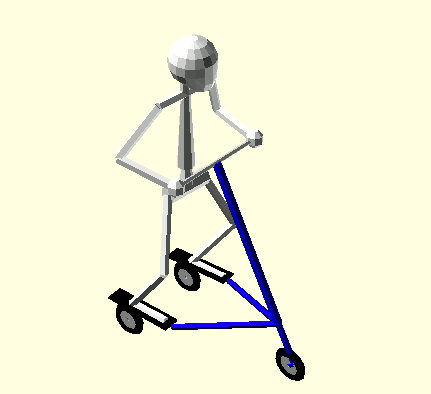
Animation 2: Hip and Shoulder Rotation Moves a Trikke
Animation 2: shows how many of us looked riding for the first time. Robo's motion is exactly the "Box Trot" of Animation 1, except the "lifted" foot never leaves the foot deck. The pivot foot is on the "inside" of the turn; the direction Robo and the Trikke are leaning, steering and cambering toward. The other foot, to the "outside" of the turn, is the "lifted" Box Trot foot.
Again, motion starts with Robo's pivot foot turning the hips to throw the other leg. Contrary to moving the box, Robo's feet are glued to the decks, not free to move. The decks can't be moved forward or backward either. So the legs accomodate by bending and guiding hip rotation via muscle tension. The pivot leg elongates, while the other folds a bit.
The legs, like the arms, are tensioned to create the body spin, pushing and pulling against the decks, grips, hips and shoulders. Since the pivot leg mostly supports the body, both the foot and upper leg are pushing. The outside leg pulls its hip forward, but feels like it's pushing the deck forward or to the side. Most pepole don't notice the hip forces and concentrate on the feet. Foot-awareness changes as riding technique improves and you become more hip and shoulder aware.
Arms are even more complicated to describe in terms of feeling the interaction. That's why it is difficult to describe what Robo is doing in terms of pushing or pulling. It's easier and more correct to say Robo is "twisting" or "spinning".
As Robo's hips turn, his body spins and that includes the shoulders. In order for the Trikke to move, to catch Robo's body spin when it starts and stops, the Trikke must be turned on a circular path; rotating around a turn center to the inside of the turn. A rider keeping arms and legs really loose like a rag doll cannot transfer momentum to the Trikke. There has to be tension between the source of the spin and the Trikke. All Robo needs to do is hold the handlebar grips with some tension at a constant distance from his body to steer the Trikke correctly. Keeping a constant distance naturally causes Robo to lean his back into the turn. Hip and shoulder spin locked together move Robo's ideally ridgid arms to complete this task. Robo has become a "zombie" Trikke warrior.
Riding a Trikke is so easy, even a zombie can do it!
Doing the Box Trot or riding like a zombie can get anyone moving on a Trikke. The essentials are all there to transfer your body's spin to the Trikke when you stop spinning and change spin direction. However, if you want to feel more relaxed, in control or just go faster, then you must kill the zombie and rotate the shoulders more. Delayed steering gets technical but the physics is very cool.
Even when doing the Box Trot, body spin produces angular momentum that first reflects and then transfers into corotation of the Trikke. When Robo starts spinning to the right, the Trikke is turned to the left. In the Box Trot, Robo begins turning the Trikke to the right but the Trikke continues to turn to the left (less and less) until the front wheel turns straight ahead. In this fraction of a second, when Robo and the Trikke are turning in opposite directions, Robo's spin (angular momentum) is reflected to the Trikke along its increasingly larger circular arc that it travels. Technically, this reflection happens because of The Law of Conservation of Angular Momentum and the Parallel Axis Theorem. They operate around Robo's body axis and the turn center acting through a virtual armature. It connects the Trikke, Robo and the turn center because the rider's arms and legs are tensed and the wheels don't slip. This is the angular momentum Reflection Phase illustrated in Figure 1 below.
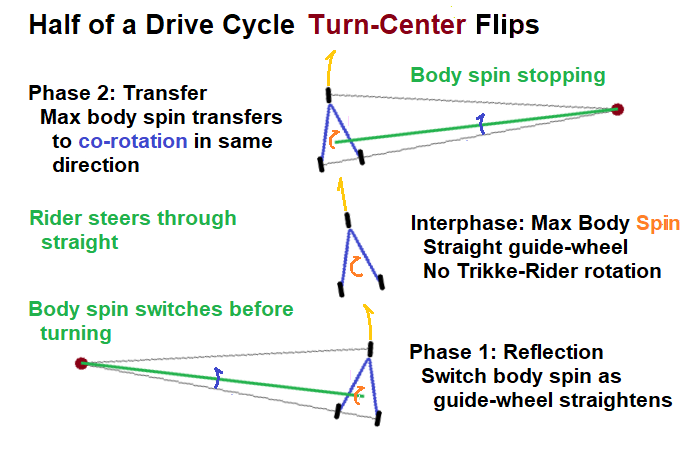
Figure 1: Phases of Trikke Corotation
Phase II in Figure 1, the angular momentum Transfer Phase, happens when Robo steers past straight causing the turn center to flip into the turn. Robo spins down and stops spinning momentarily transfering angular momentum to the Trikke because his arms and legs are tensioned. The same law and theorem apply with different initial conditions through the virtual (green) armature to explain the transfer. See Figure 1 for a summary of the 3 parts and two phases of a Trikke half-cycle.
How can Robo take advantage of knowing how a Trikke is powered? With the Box Trot, there is reflection and transfer but there can be more. To take advantage of the Reflection Phase, we must first realize that reflection shares Robo's increasing momentum equally between the Trikke and himself. That's because it is conserved - that's the law. Robo is working twice as hard during the reflection phase to have the other half of his angular momentum transferred in Phase II. In fact, the conservation law does not allow any angular momentum ginned up during Phase II to be transferred - it is wasted. Robo can only gin up angular momentum in Phase I, half being reflected but the other half is carried over to and transfered in Phase II.
So how does Robo increase his angular momentum throughout the reflection phase? The answer is to develop more shoulder rotation and to delay steering! More shoulder rotation always increases total body spin. When Robo starts to spin in the other direction and does not steer, as in Animation 3, he still reflects up-spin to the Trikke. Phase II starts when the Trikke turns past straight ahead. But half of any angular momentum gained before turning past straight will be transfered in Phase II. Delayed steering gives Robo more time to max out his angular momentum as the Trikke steers past straight. However, Robo must not stop spinning before Phase II starts. If he waits that long to turn the Trikke, none of his spin's momentum will be transferred.
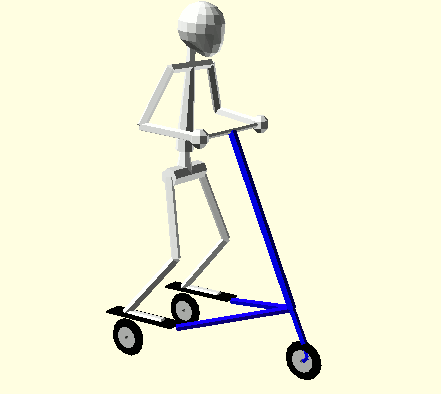
Animation 3: Hip and more Shoulder Rotation with delayed Turns
There are a couple more ways to improve your ride. Can you see Robo applying them in Animation 4?
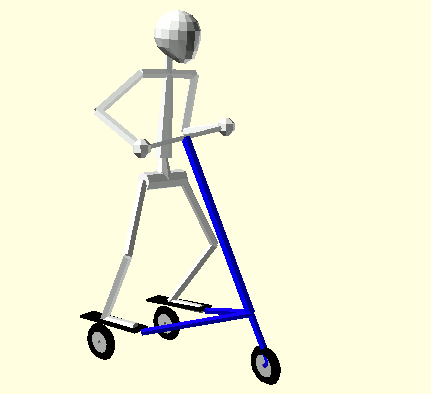
Animation 4: Hip with more Shoulder Rotation, less Steering, Cambering and no Rider Lean
Your magic carpet ride is ready to leave when you are.
© Copyright 2023 Michael Lastufka